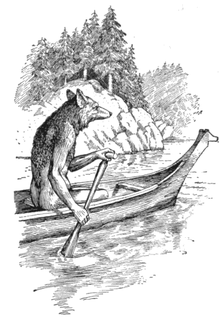- Coyote in mythology
-
Coyote is a mythological character common to many Native American cultures, based on the coyote (Canis latrans) animal. This character is usually male and is generally anthropomorphic although he may have some coyote-like physical features such as fur, pointed ears, yellow eyes, a tail and claws. The myths and legends which include Coyote vary widely from culture to culture.
Coyote shares many traits with the mythological figure Raven.
Contents
By culture
 The coyote (Canis latrans), the animal on which the myths are based
The coyote (Canis latrans), the animal on which the myths are based
Coyote is a figure in the following cultural areas of the Americas, as commonly defined by ethnographers:
California
Coyote is featured in the culture of the following groups who live in the area covered by the state of California: the Karuk,[1] the Maidu of Northern California, the Tongva of Southern California, the Ohlone mythology of Northern California, the Miwok mythology of Northern California, and the Pomo mythology of Northern California
Great Plains
Coyote is seen in the cultural heritage of these people of the Great Plains area: the Crow mythology (Crow Nation), the Ho-Chunk mythology (Ho-Chunk, Winnebago), and the Menominee.
Plateau
Myths and stories of Coyote are also found in the cultures of the Plateau area: the Chinookan (including the Wishram people and the Multnomah),[2] the Flathead,[3] the Nez Perce,[4] the Nlaka'pamux, the Syilx (Okanagan), the St'at'imc, the Tsilhqot'in, and the Yakama.[5]
Functional cognates
See also: TricksterCoyote has been compared to both the Scandinavian Loki, and also Prometheus, who shared with Coyote the trick of having stolen fire from the gods as a gift for mankind, and Anansi, a mythological culture hero from Western African mythology. In Eurasia, rather than a coyote, a fox is often featured as a trickster hero, ranging from kitsune (fox) tales in Japan to the Reynard cycle in Western Europe. Similarities can also be drawn with another trickster, the Polynesian demigod Māui, who also stole fire for mankind and introduced death to the world.
Claude Lévi-Strauss, French anthropologist proposed a structuralist theory that suggests that Coyote and Crow obtained mythic status because they are mediator animals between life and death.[6]
Coyote in the modern world
Coyote figures prominently in current efforts to educate young people about Western Native American languages and cultures. For example, the Secwepemc people of the Kamloops Indian Band in Kamloops, British Columbia, Canada, have designated their recently opened native elementary school the Sk'elep (Coyote) School of Excellence, while educational websites such as one co-sponsored by the Neskonlith Indian Band of Chase, British Columbia prominently feature stories about Sk'elep.[7]
Peter Blue Cloud (Aroniawenrate) is a member of the Turtle clan of the Mohawk Nation. His books include two collections of contemporary Coyote tales, Elderberry Flute Song and The Other Side of Nowhere, which place Coyote in a number of different guises—showing Coyote to be funny, wise, sad, and sexual. William Bright's collection, A Coyote Reader, also shows the continuing importance of Coyote in today's world.
Coyote in popular culture
Main article: Coyotes in popular cultureThe coyote is a popular figure in folklore and popular culture. Modern references may invoke either the animal or the mythological figure. Traits commonly described in pop culture appearances include inventiveness, mischievousness, and evasiveness.
Coyote's mythological role as a trickster is the basis for American sex workers' modern adoption of the coyote in service to advocacy[citation needed] in their industry – "COYOTE" ("Call Off Your Old Tired Ethics") is the name of a group established in 1973 in San Francisco to advocate for sex workers in political issues and to help prostitutes who want to leave the business.
References
- ^ Karuk stories
- ^ Chinookan stories
- ^ Flathead stories
- ^ Nez Perce Stories
- ^ Other stories from Plateau tribes
- ^ Lévi-Strauss, Claude. Structural Anthropology. Trans. Claire Jacobson. New York: Basic Books, 1963. (p. 224)
- ^ Stseptekwle legends [pronounced S-chep-tek-wool-eh]
External links
Categories:- Trickster gods
- Mythological canines
- Mythology of the indigenous peoples of North America
Wikimedia Foundation. 2010.

